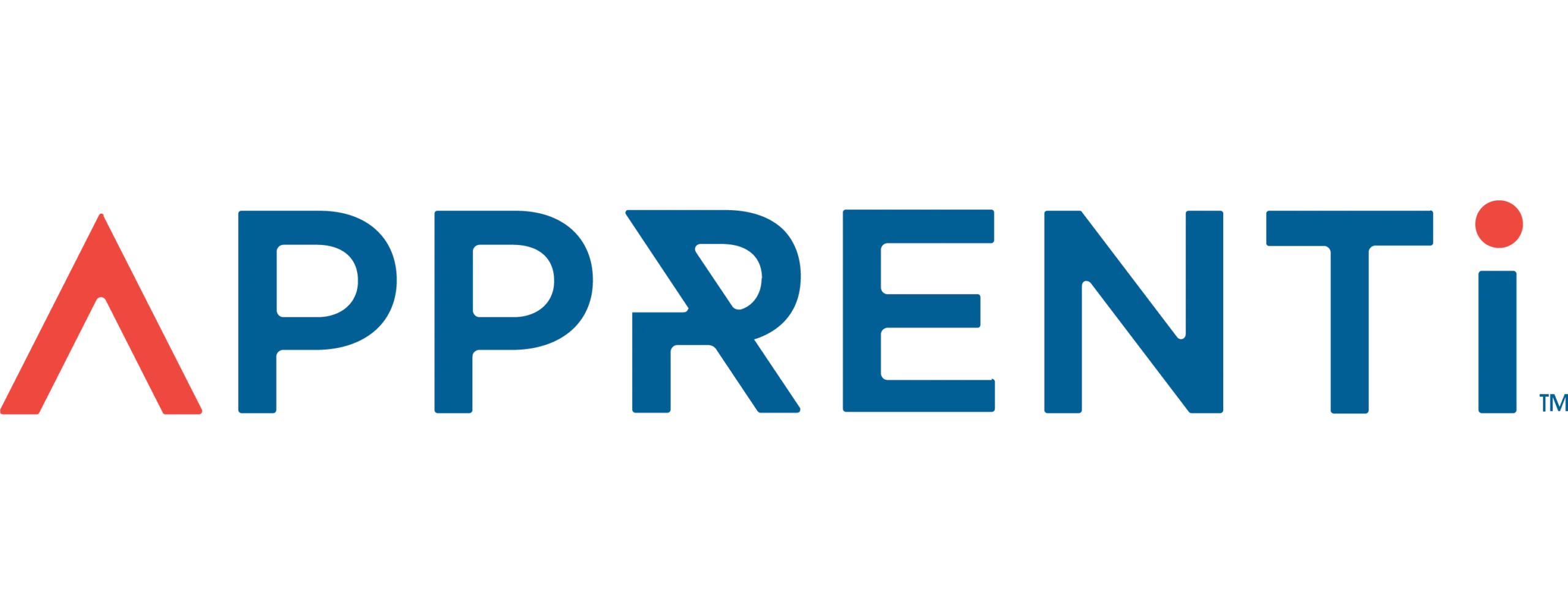Article Summary
- Define clear objectives for your apprentice management program to ensure alignment with both company goals and the professional growth of your apprentices.
- Implement a structured framework for training, tracking, and compliance to bring consistency and efficiency to your apprentice management processes.
- Leverage digital apprentice management tools to streamline communication, automate administrative tasks, and gain data-driven insights that improve program performance.
Want to Learn More About Your Registered Apprenticeship Opportunities?
BOOK A FREE CONSULTATION
Let’s Talk About Modern Apprentice Management
Managing apprentice management across multiple tracks can often feel like juggling far too many things at once. Between internal systems, spreadsheets, and manual processes, it becomes time-consuming, error-prone, and unsustainable at scale. But what if there was a better way? Modern apprentice management tools bring clarity and efficiency to the process, helping employers build a skilled workforce while creating meaningful pathways for youth.
Set Clear Program Goals
Before you dive into the nitty-gritty of apprentice management, you’ve got to know what you’re aiming for. What does success look like for your apprenticeship programs? Are you trying to fill specific skill gaps, develop future leaders, or improve retention? Setting SMART (Specific, Measurable, Achievable, Relevant, Time-bound) goals is crucial. These objectives should not only align with your overall business strategy but also with the developmental needs of your apprentices. Think of it as drawing the map before you start the journey – it ensures everyone is heading in the same direction.
Build Strong Training Frameworks
A successful apprenticeship isn’t just about throwing someone into a role and hoping for the best. It requires a well-thought-out training framework that includes:
- On-the-Job Training (OJT): Practical skills learned in a real-world environment.
- Related Technical Instruction (RTI): Classroom-based learning for theoretical knowledge.
- Mentorship: Guidance from experienced professionals.
A structured framework ensures consistency across different apprenticeship tracks and provides a clear path for skill acquisition. This structure is fundamental to quality management in any training endeavor.
Track Progress Effectively
Effective progress tracking goes beyond simple check-ins. It involves monitoring skills milestones, conducting regular performance reviews, and gathering feedback. This data isn’t just for evaluation; it’s a goldmine for program improvement. When you can see what’s working and what’s not, you can make informed decisions to enhance the learning experience for everyone involved.
Maintain Compliance Standards
Compliance is a non-negotiable element of apprentice management, especially for Registered Apprenticeship Programs. Keeping up with evolving regulations, documentation, and reporting requirements can be a significant burden for HR teams managing multiple tracks.
However, maintaining these standards is crucial for both program legitimacy and eligibility for funding or certifications. Fortunately, modern apprentice management systems can dramatically simplify compliance by automating documentation, providing real-time audit trails, and generating reports on demand. This not only reduces administrative strain but also helps organizations stay proactive rather than reactive when it comes to meeting compliance expectations.

Pro tip: Regularly solicit feedback from apprentices, mentors, and RTI providers about the program structure. This iterative approach helps refine goals and frameworks for maximum impact and ensures everyone feels like part of a collaborative effort.
What Makes Apprenticeships So Valuable?
Apprenticeships are more than training initiatives; they’re strategic investments in your future workforce. When managed well, their value multiplies across your organization.
Develop Future Leaders
Apprenticeships allow you to build leadership from within. You’re not just teaching skills; you’re instilling your company culture and vision from day one. Early immersion often leads to stronger loyalty and long-term commitment.
Close Skills Gaps
Apprenticeships directly address industry-specific talent shortages. By tailoring training to your needs, you’re not waiting for the perfect candidate—you’re developing them.
Reduce Training Costs
The “earn while you learn” model benefits both parties. Apprentices gain experience and income, while employers reduce recruitment and onboarding costs. Plus, funding programs and incentives can offset training expenses.
Pro tip: Document the specific skills being developed in each apprenticeship track. This not only helps in measuring success but also in clearly articulating the tangible value of these programs to internal stakeholders and potential new apprentices.
Here’s How to Support Your Apprentices
An apprentice’s journey is a period of intense learning and growth, but it’s one that requires robust support systems to ensure they truly thrive. As an HR executive juggling multiple apprenticeship tracks, you understand that a well-supported apprentice is more engaged, learns more effectively, and is far more likely to become a valuable long-term asset to your company. It’s about creating an environment where young talent can flourish and see a real future. Understanding why apprenticeships are so beneficial can help in designing these support structures.
Create Mentorship Programs
Mentorship is a cornerstone of successful apprentice management. A good mentor does more than just teach technical skills; they provide guidance, encouragement, act as a sounding board, and help the apprentice navigate the workplace culture. Consider these aspects for your mentorship program:
- Pairing apprentices with experienced employees who are passionate about sharing knowledge.
- Providing mentors with training on how to effectively guide and support apprentices.
- Establishing regular check-ins between mentors and apprentices. A dedicated mentorship program is arguably one of the most impactful ways to support apprentices, providing guidance, encouragement, and a personal connection to the organization.

Establish Clear Milestones
Imagine trying to run a marathon without knowing where the finish line is – that’s what an apprenticeship can feel like without clear milestones. These milestones serve as a roadmap for development, breaking down the overall learning journey into manageable steps. They help keep apprentices motivated, provide a sense of accomplishment, and make it easier to track progress and identify areas where additional support might be needed. This clarity is vital for both the apprentice and the program managers.
Provide Regular Feedback
Feedback is the breakfast of champions, and it’s absolutely essential for apprentice development. This isn’t just about annual reviews; it’s about providing regular, constructive, and timely feedback through both formal and informal channels. Apprentices need to know what they’re doing well and where they can improve. This continuous dialogue helps them adjust their approach, reinforces learning, and demonstrates that the company is invested in their growth. Clearly defined milestones and regular, constructive feedback are crucial for keeping apprentices engaged and ensuring their skill development stays aligned with program objectives.
Offer Growth Opportunities
What happens after the apprenticeship ends? Showing apprentices a clear path for career advancement within the company is a powerful motivator. This could involve opportunities for further education, promotions, or transitions into different roles. When apprentices see that their hard work can lead to a fulfilling, long-term career with your organization, their commitment and loyalty deepen significantly. Thinking beyond the immediate apprenticeship and showcasing clear pathways for career progression within the company can dramatically increase apprentice retention and motivation.
Pro tip: Encourage mentors to share not just technical skills but also crucial “soft skills” and insights into the company culture. This holistic approach accelerates an apprentice’s integration and overall professional development.
Let’s Explore Digital Management Tools
If you’re still wrestling with a mountain of spreadsheets, scattered documents, and endless email chains to manage your various apprenticeship tracks, you know the pain. It’s time for an upgrade!
Digital apprentice management tools aren’t just a fancy add-on anymore; they’re becoming absolutely essential for driving efficiency, ensuring compliance, and providing a much smoother experience for everyone involved – HR, mentors, and the apprentices themselves. Think of it as trading in your old paper map for a sophisticated GPS to navigate your programs. These tools can manage various work-based learning programs, and it’s helpful to understand the nuances, for example, between apprenticeships vs. internships, to configure them correctly.

Streamline Documentation Process
One of the biggest headaches in apprentice management is handling all the paperwork. Digital tools offer a centralized, secure repository for all apprentice-related documents – from applications and training plans to performance reviews and compliance forms. This means:
- Easy access for authorized personnel whenever and wherever they need it.
- Reduced risk of lost or misplaced documents.
- A significant decrease in administrative burden, freeing up your team for more strategic tasks. Digital apprentice management platforms transform cumbersome paper-based processes into streamlined, automated workflows, freeing up valuable HR time.
Automate Progress Tracking
Manually tracking On-the-Job Training (OJT) hours, Related Technical Instruction (RTI) completion, and skills attainment is prone to errors and incredibly time-consuming. Digital platforms can automate much of this. Imagine real-time visibility into each apprentice’s progress, automated reminders for evaluations, and digital logs that are always up-to-date. This not only saves time but also provides valuable data for assessing program effectiveness and individual apprentice needs. Automated progress tracking provides unparalleled visibility into each apprentice’s journey, enabling timely interventions and personalized support.
Enable Real-time Communication
Effective communication is key to any successful program. Digital apprentice management tools often include built-in communication features, such as dedicated channels for program announcements, forums for discussion, and direct messaging capabilities. This fosters a more connected environment, allowing for quick feedback, rapid issue resolution, and ensuring that everyone – apprentices, mentors, instructors, and HR – stays informed and engaged. Real-time communication features within a dedicated platform foster a more connected and responsive apprenticeship environment, improving engagement and problem-solving.
Pro tip: When evaluating digital tools, look for platforms that offer robust integration capabilities with your existing HRIS or Learning Management Systems (LMS). This ensures seamless data flow, avoids data silos, and creates a more unified and efficient tech ecosystem for your HR functions.
Here’s How to Measure Program Success
That old saying, “What gets measured, gets managed,” couldn’t be more accurate when it comes to apprenticeship programs. To truly understand their impact, demonstrate their value, and justify continued (or increased!) investment, you need robust and clear ways to measure success. It’s not just about seeing who completes the program; it’s about identifying the tangible benefits for both the apprentices and your organization as a whole. Sharing these success stories and program insights can also be a great way to engage with the broader workforce development community, perhaps even through platforms like LinkedIn.
Review Completion Rates
This is often the first metric people look at, and it’s certainly essential. A high completion rate can indicate a well-structured program with good support, while a low rate might signal issues that need addressing. However, don’t stop here. Dig deeper into the factors influencing these rates. Are there common roadblocks? Are expectations clear from the outset?
Assess Skill Development
Ultimately, the goal of an apprenticeship is to develop specific skills and competencies. How are you measuring this? Consider implementing:
- Pre- and post-program skills assessments.
- Competency attainment tracking against defined learning objectives.
- Regular feedback from supervisors and mentors on the apprentice’s job readiness and performance. Beyond simple completion rates, a comprehensive assessment of skill development provides a more accurate picture of your apprenticeship program’s effectiveness in building a competent workforce.

Calculate ROI Benefits
For any HR initiative, demonstrating a return on investment is key. With apprenticeships, this can involve several factors. You can compare the cost of training an apprentice to the cost of hiring an already skilled employee (if available!). Factor in the productivity gains from apprentices as they progress and contribute to real work. And don’t forget the long-term value of retaining these individuals once they complete their programs. Digital tools can provide valuable data for these calculations. Calculating the ROI of your apprenticeship programs involves looking at direct cost savings, productivity contributions, and the long-term value of talent retention.
Track Career Advancement
What happens to your apprentices after they graduate? Tracking their career advancement within your organization is a powerful indicator of program success. Are they being placed in full-time roles? Are they receiving promotions and salary increases at a good pace? A strong internal talent pipeline built through apprenticeships is a significant strategic advantage. Tracking the career advancement of graduated apprentices within your organization is a powerful indicator of program success and its contribution to your talent pipeline.
Pro tip: Establish baseline metrics before implementing significant changes or introducing new tools in your apprentice management strategy. This will allow you to clearly and objectively demonstrate the impact of your initiatives over time.
Conclusion: Master Your Apprentice Management Strategy
Managing multiple, complex apprenticeship tracks doesn’t have to be overwhelming. By applying strong apprentice management practices and leveraging digital tools, you can streamline operations, boost compliance, and deliver powerful workforce outcomes.
With a proactive approach and the right strategy, you can shift from reactive oversight to intentional development. Apprentice management, when thoughtfully executed, becomes a driver of organizational resilience, culture-building, and long-term growth.
Focus on strategic alignment, structured support, and tech integration to elevate your programs. When done right, apprentice management becomes more than a task—it becomes a cornerstone of your organization’s growth and talent strategy.

Frequently Asked Questions
- Q: What’s the most overlooked factor in effective apprentice management?
- A: Start by clearly defining your program goals and auditing your current processes to identify pain points and areas for improvement. Understanding where you are is key to getting where you want to be.
- Q: How can digital tools help with compliance for registered apprenticeships?
- A: Digital tools can automate the tracking of required training hours, maintain comprehensive records, and generate reports needed for compliance, significantly reducing the administrative burden and risk of errors.
- Q: What’s a common mistake companies make in apprentice management?
- A: A common mistake is underestimating the importance of structured mentorship and regular, constructive feedback. These elements are crucial for apprentice development and engagement.
- Q: How do we ensure consistency across multiple apprenticeship tracks?
- A: Implementing standardized frameworks for training, progress tracking, and evaluation, ideally managed through a centralized platform, is key to ensuring consistency across different apprenticeship tracks.
- Q: Can small businesses also benefit from formal apprentice management?
- A: Absolutely! While the scale might be different, the principles of clear goals, structured training, and effective tracking are just as beneficial for small businesses looking to develop skilled talent.















